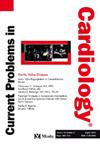The diagnosis and treatment of asymptomatic and symptomatic patients with carotid artery stenosis
IF 3.3
3区 医学
Q2 CARDIAC & CARDIOVASCULAR SYSTEMS
引用次数: 0
Abstract
Carotid artery atherosclerotic stenosis is an important annual cause of stroke in the United States. Moreover, the incidence of carotid artery stenosis is significantly increasing due to the widespread popularity of high fat and high salt diets, sedentary lifestyles, and the increasing age of the population. Of major importance to cardiovascular specialists is the fact that individuals with atherosclerotic carotid artery stenosis can have a prevalence of atherosclerotic coronary artery disease as high as 50 to 75%.
Vascular screening for carotid artery stenosis with Doppler ultrasound should be considered for all symptomatic patients with possible carotid stenosis and also considered for asymptomatic patients with (1) symptomatic peripheral arterial disease, coronary artery disease, or atherosclerotic aortic aneurysm or, (2) multiple atherosclerotic risk factors.
Carotid artery atherosclerotic plaques that are at high risk for rupture and thrombosis or cerebral embolization are characterized by large lipid cores, intraplaque hemorrhage, thin fibrous caps less than 165 μms that are infiltrated by macrophages and T cells or have surface ulcer(s) or fissures. Carotid artery plaque rupture with cerebral embolism can cause a stroke, transient ischemic attacks (TIA), or ipsilateral blindness (amaurosis fugax).
Medical treatment based on the recommendations of the American and European Societies for Vascular Surgery and the American Heart Association for symptomatic patients with carotid stenosis and also asymptomatic patients with high risk carotid stenosis plaques include antiplatelet drugs, antihypertensive drugs for hypertension control and lipid lowering drugs. Management strategies and decisions about carotid revascularization in asymptomatic patients with high risk carotid stenosis should involve a multidisciplinary team and shared decision-making is recommended.
The 30 day and five to 10 year outcomes in asymptomatic carotid stenosis patients who have undergone carotid endarterectomy, carotid stenting and/or optimal medical therapy are summarized from the Veterans Administration Cooperative Study, the Asymptomatic Carotid Atherosclerosis Study and the Asymptomatic Carotid Surgery Trials. The current Carotid Revascularization and Medical Management for Asymptomatic Carotid Stenosis Trial (CREST-2) should help to resolve the debate regarding carotid artery revascularization versus primary medical treatment in asymptomatic patients with >70% carotid artery stenosis.
Symptomatic patients who present within 4.5 hours of stroke onset require evaluation for acute intravenous pharmacologic thrombolysis and patients who present with large vessel occlusion within 24 hours of symptom onset should be considered for mechanical thrombectomy to reduce the neurologic deficit. Patients with carotid artery stenosis who present with a history of cerebral infarct in the preceding six months due to cerebral embolism require medical treatment and evaluation by a multidisciplinary team for carotid revascularization in order to prevent future strokes or TIAs. The outcomes of the North American Symptomatic Carotid Endarterectomy Trial, Carotid Revascularization Endarterectomy Versus Stent Trial, Stent-Supported Percutaneous Angioplasty of the Carotid Artery vs. Endarterectomy Trial, and the Safety and Efficacy Study for Reverse Flow Used during Carotid Artery Stenting Procedure trials for symptomatic patients with carotid stenosis are reviewed. A synopsis of treatment guidelines for symptomatic and asymptomatic carotid stenosis patients from the American and European Societies of Vascular Surgery and the American Heart Association/American Stroke Association are presented.
Each patient with carotid artery stenosis must be carefully evaluated to determine the best treatment based on the clinical presentation, the imaging and laboratory diagnostic information, the treatment guidelines, and the patient needs and preferences as well as the patient's social and cultural factors.
无症状与有症状颈动脉狭窄患者的诊断与治疗。
在美国,颈动脉粥样硬化性狭窄是每年导致中风的重要原因。此外,由于高脂肪、高盐饮食的普遍流行、久坐不动的生活方式以及人口年龄的增长,颈动脉狭窄的发病率正在显著增加。对心血管专家来说,最重要的是,动脉粥样硬化性颈动脉狭窄的患者患动脉粥样硬化性冠状动脉疾病的比例可高达50%至75%。对于所有可能有颈动脉狭窄症状的患者,均应考虑多普勒超声血管筛查颈动脉狭窄,同时也应考虑有(1)症状性外周动脉疾病、冠状动脉疾病或动脉粥样硬化性主动脉瘤或(2)多种动脉粥样硬化危险因素的无症状患者。颈动脉粥样硬化斑块是破裂和血栓形成或脑栓塞的高风险斑块,其特征是脂质核大,斑块内出血,纤维帽薄,小于165 μms,被巨噬细胞和T细胞浸润或表面有溃疡或裂隙。颈动脉斑块破裂伴脑栓塞可引起中风、短暂性脑缺血发作或同侧失明(黑朦)。根据欧美血管外科学会对有症状的颈动脉狭窄患者和无症状的颈动脉狭窄高危斑块患者的建议,药物治疗包括抗血小板药物、降压药和降脂药物。无症状的高危颈动脉狭窄患者的颈动脉血管重建术的管理策略和决策应涉及多学科团队,并建议共同决策。从退伍军人管理局合作研究、无症状颈动脉粥样硬化研究和无症状颈动脉手术试验中总结了无症状颈动脉狭窄患者接受颈动脉内膜切除术、颈动脉支架置入和/或最佳药物治疗的30天和5至10年的结局。目前的无症状颈动脉狭窄的颈动脉重建术和医疗管理试验(CREST-2)应该有助于解决关于颈动脉重建术与初级药物治疗在无症状颈动脉狭窄患者中的争论。在中风发作4.5小时内出现症状的患者需要评估急性药物静脉溶栓,在症状发作24小时内出现大血管闭塞的患者应考虑机械取栓,以减少神经功能缺损。颈动脉狭窄患者在过去6个月内因脑栓塞而出现脑梗死病史,需要由多学科团队进行颈动脉血运重建治疗和评估,以预防未来的中风或短暂性脑缺血发作。本文综述了北美症状性颈动脉内膜切除术试验、颈动脉血管重建术与支架试验、支架支持的颈动脉经皮血管成形术与动脉内膜切除术试验的结果,以及颈动脉支架置入术试验中用于颈动脉狭窄症状患者的逆流安全性和有效性研究。本文简要介绍了欧美血管外科学会和美国心脏协会/美国卒中协会对有症状和无症状颈动脉狭窄患者的治疗指南。每位颈动脉狭窄患者必须仔细评估,根据临床表现、影像学和实验室诊断信息、治疗指南、患者需求、偏好以及患者的社会和文化因素确定最佳治疗方案。
本文章由计算机程序翻译,如有差异,请以英文原文为准。
求助全文
约1分钟内获得全文
求助全文
来源期刊

Current Problems in Cardiology
医学-心血管系统
CiteScore
4.80
自引率
2.40%
发文量
392
审稿时长
6 days
期刊介绍:
Under the editorial leadership of noted cardiologist Dr. Hector O. Ventura, Current Problems in Cardiology provides focused, comprehensive coverage of important clinical topics in cardiology. Each monthly issues, addresses a selected clinical problem or condition, including pathophysiology, invasive and noninvasive diagnosis, drug therapy, surgical management, and rehabilitation; or explores the clinical applications of a diagnostic modality or a particular category of drugs. Critical commentary from the distinguished editorial board accompanies each monograph, providing readers with additional insights. An extensive bibliography in each issue saves hours of library research.
 求助内容:
求助内容: 应助结果提醒方式:
应助结果提醒方式:


